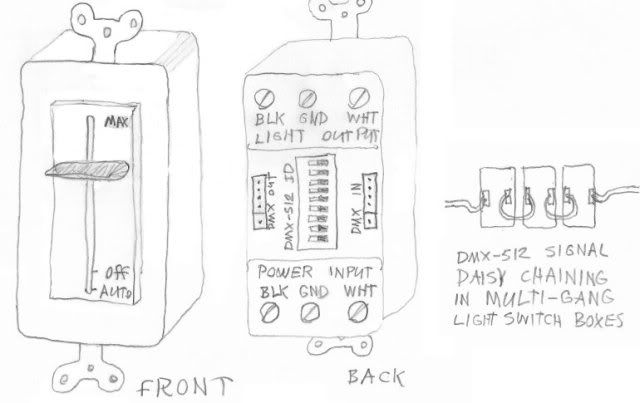The lighting for the stage is currently about six rows of eight 150 watt incandescent flood lamps (1200 watts per row), each going to it's own typical On/Off wall toggle switch.
I would like to have the option of either manually dimming the lights from the current switch location, or remotely dimming the lights from a DMX light controller in the gym, for theatrical use.
Here is what I envision this might look like:

* For the upper sliding part Off to Max, it is a normal manual wall dimmer control.
* For DMX operation the slide is moved down to the Auto position, with a tactile detent from Off to Auto, so that it is firmly held in the Auto position.
* The DMX-IN / DMX-OUT sockets are keyed so the DMX cable only connects one way.
* For side-by-side ganging, the DMX daisy chain jumper cable is about 6-8 inches long to give enough slack for removing the module from the wall box.
* I didn't draw this in, but a 10-position DIP switch would allow one of the switches for built-in DMX end-of-chain termination, leaving 9 switches for the 512 addresses
* Decora style light switch plate, with the DMX channel written on the wallplate below the slide
Does anyone know where I might find such a control? I know there are special terms used for such things, such as "architectural lighting" etc, so it's very hard to find what I'm looking for since I don't know its formal name.
If nothing like this exists, will someone please build it? Regarding patenting, licensing, blah blah, I don't have the money or the technical design and manufacturing capability to make this myself. So I will settle for someone else making the profit off of it, if I can just buy it for my school a reasonable price.
Dale Mahalko
Tech Support / Network Admin
Cornell School District, Cornell, WI
Lake Holcombe School District, Holcombe, WI